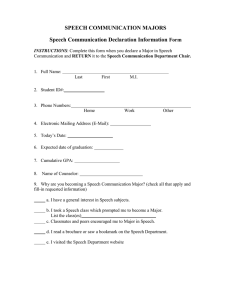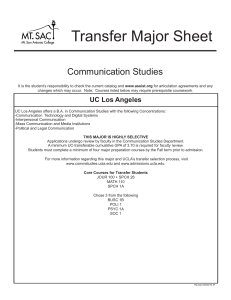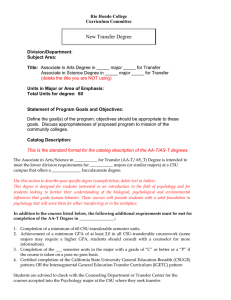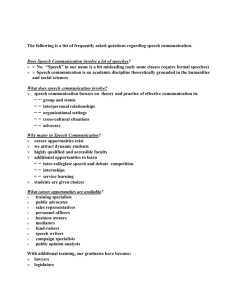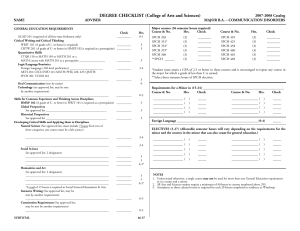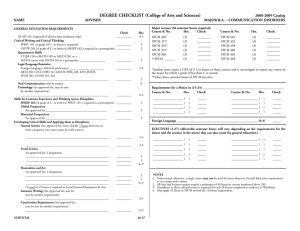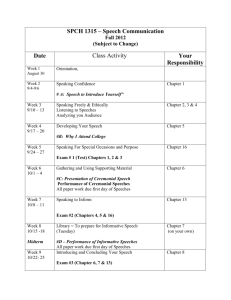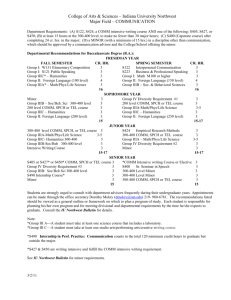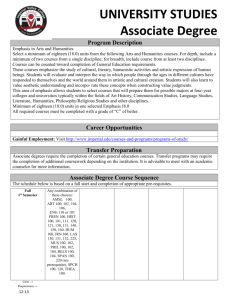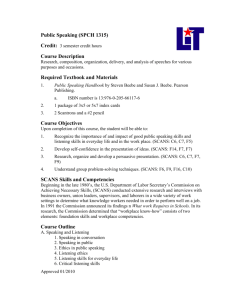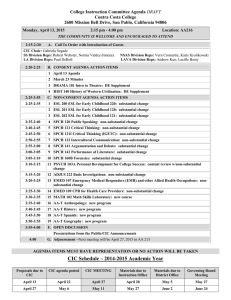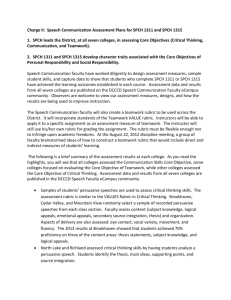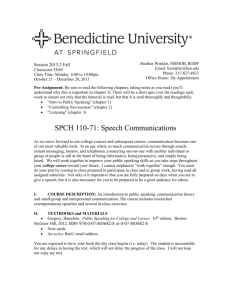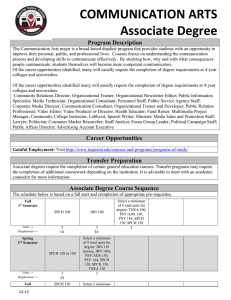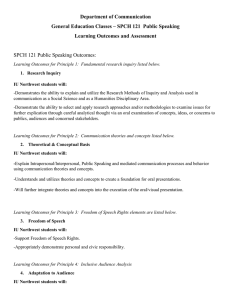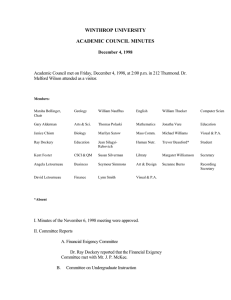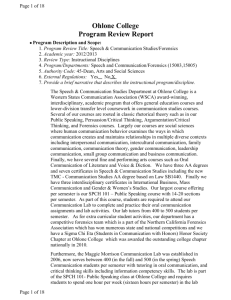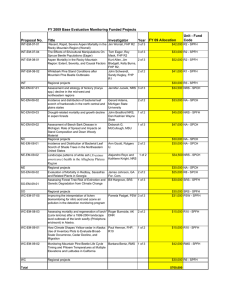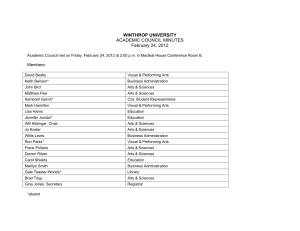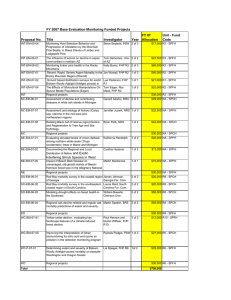II - College of San Mateo
advertisement
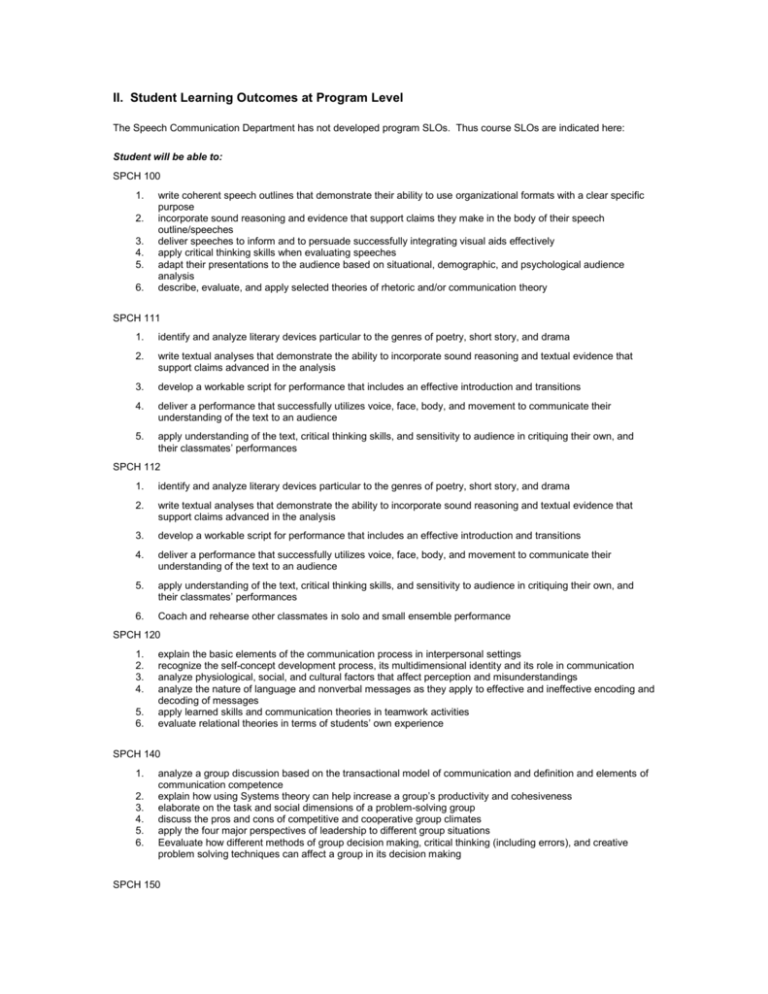
II. Student Learning Outcomes at Program Level The Speech Communication Department has not developed program SLOs. Thus course SLOs are indicated here: Student will be able to: SPCH 100 1. 2. 3. 4. 5. 6. write coherent speech outlines that demonstrate their ability to use organizational formats with a clear specific purpose incorporate sound reasoning and evidence that support claims they make in the body of their speech outline/speeches deliver speeches to inform and to persuade successfully integrating visual aids effectively apply critical thinking skills when evaluating speeches adapt their presentations to the audience based on situational, demographic, and psychological audience analysis describe, evaluate, and apply selected theories of rhetoric and/or communication theory SPCH 111 1. identify and analyze literary devices particular to the genres of poetry, short story, and drama 2. write textual analyses that demonstrate the ability to incorporate sound reasoning and textual evidence that support claims advanced in the analysis 3. develop a workable script for performance that includes an effective introduction and transitions 4. deliver a performance that successfully utilizes voice, face, body, and movement to communicate their understanding of the text to an audience 5. apply understanding of the text, critical thinking skills, and sensitivity to audience in critiquing their own, and their classmates’ performances SPCH 112 1. identify and analyze literary devices particular to the genres of poetry, short story, and drama 2. write textual analyses that demonstrate the ability to incorporate sound reasoning and textual evidence that support claims advanced in the analysis 3. develop a workable script for performance that includes an effective introduction and transitions 4. deliver a performance that successfully utilizes voice, face, body, and movement to communicate their understanding of the text to an audience 5. apply understanding of the text, critical thinking skills, and sensitivity to audience in critiquing their own, and their classmates’ performances 6. Coach and rehearse other classmates in solo and small ensemble performance SPCH 120 1. 2. 3. 4. 5. 6. explain the basic elements of the communication process in interpersonal settings recognize the self-concept development process, its multidimensional identity and its role in communication analyze physiological, social, and cultural factors that affect perception and misunderstandings analyze the nature of language and nonverbal messages as they apply to effective and ineffective encoding and decoding of messages apply learned skills and communication theories in teamwork activities evaluate relational theories in terms of students’ own experience SPCH 140 1. 2. 3. 4. 5. 6. analyze a group discussion based on the transactional model of communication and definition and elements of communication competence explain how using Systems theory can help increase a group’s productivity and cohesiveness elaborate on the task and social dimensions of a problem-solving group discuss the pros and cons of competitive and cooperative group climates apply the four major perspectives of leadership to different group situations Eevaluate how different methods of group decision making, critical thinking (including errors), and creative problem solving techniques can affect a group in its decision making SPCH 150 1. 2. 3. 4. 5. 6. explain the relationship of culture and communication using a model of intercultural communication differentiate between the macrocultures and microcultures within the U.S. and discuss the influence they have upon one another distinguish between attitudes, beliefs, and values and critically analyze different value orientations discuss overt and covert cultural behaviors that manifest in the form of prejudice, discrimination, and ethnocentrism to increase self-awareness of factors that contribute to these social ills show knowledge and appreciation of different ways that cultural groups raise their families, educate, practice religion, practice politics, and run their economies demonstrate knowledge of how different cultures use verbal and nonverbal communication SPCH 180 1. 2. 3. 4. 5. 6. identify communication patterns and rules in real families and families portrayed in the media explain the characteristics and communication issues of various family types explain the role of culture and multigenerational influence in family functioning describe key communication patterns and issues unique to different family forms identify and recognize the importance of the role of communication rituals in families describe the constructive/destructive styles of family conflict

